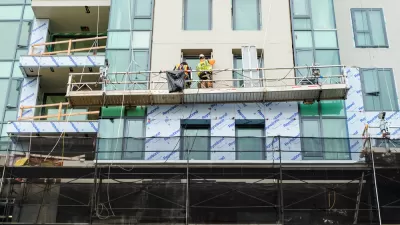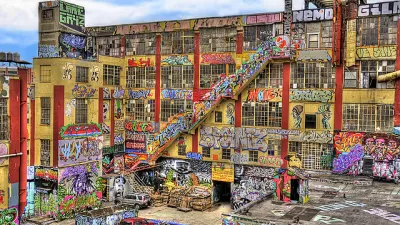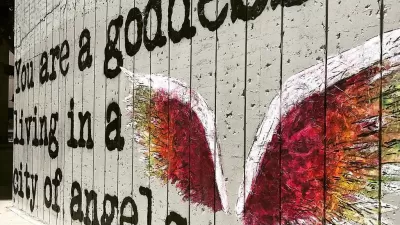After billionaire landlord Dan Gilbert commissioned a mural, less-legal works in Fairey's style began showing up around the city. Detroit's case against the artist brings gentrification's ironies into focus.

Detroit has moved to prosecute Shepard Fairey, the street artist behind "the much-imitated 'Hope' poster that came to symbolize Barack Obama's 2008 presidential campaign, and the 'Obey' series that features the enigmatic face of the wrestler Andre the Giant."
Invited to the city by Quicken Loans founder Dan Gilbert, Fairey "may not have been willing to color entirely within the lines. When he came to Detroit to do the job, several other works in his signature style showed up wheat-pasted around town [...] Now the city is prosecuting the artist on felony charges of malicious destruction of property, claiming that he caused as much as $30,000 in damage."
Fairey's arrest evokes a certain irony. Gentrifying developers "want neighborhoods to be 'colorful' and 'edgy,' with exciting 'street culture' that draws younger consumers to spend dollars in cafes and bars and boutiques—and ultimately to settle down in pricy loft-style apartments, fattening the tax rolls."
But a disconnect remains between "municipal dreams of a city where artists drive economic growth in an orderly, controlled way, and the reality of how artists see the world—or how they want to be seen." Is street art okay in a city like Detroit? Does graffiti attract the "wrong" people—or the right ones? These questions remain unanswered.
FULL STORY: The Mainstream Appeal of Outlaw Street Art

Alabama: Trump Terminates Settlements for Black Communities Harmed By Raw Sewage
Trump deemed the landmark civil rights agreement “illegal DEI and environmental justice policy.”

Planetizen Federal Action Tracker
A weekly monitor of how Trump’s orders and actions are impacting planners and planning in America.

Why Should We Subsidize Public Transportation?
Many public transit agencies face financial stress due to rising costs, declining fare revenue, and declining subsidies. Transit advocates must provide a strong business case for increasing public transit funding.

Understanding Road Diets
An explainer from Momentum highlights the advantages of reducing vehicle lanes in favor of more bike, transit, and pedestrian infrastructure.

New California Law Regulates Warehouse Pollution
A new law tightens building and emissions regulations for large distribution warehouses to mitigate air pollution and traffic in surrounding communities.

Phoenix Announces Opening Date for Light Rail Extension
The South Central extension will connect South Phoenix to downtown and other major hubs starting on June 7.
Urban Design for Planners 1: Software Tools
This six-course series explores essential urban design concepts using open source software and equips planners with the tools they need to participate fully in the urban design process.
Planning for Universal Design
Learn the tools for implementing Universal Design in planning regulations.
Caltrans
Smith Gee Studio
Institute for Housing and Urban Development Studies (IHS)
City of Grandview
Harvard GSD Executive Education
Toledo-Lucas County Plan Commissions
Salt Lake City
NYU Wagner Graduate School of Public Service





























